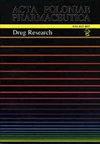水飞蓟素对糖尿病大鼠心脏氧化应激参数的影响
IF 0.4
4区 医学
Q4 PHARMACOLOGY & PHARMACY
引用次数: 0
摘要
慢性高血糖是糖尿病中氧自由基形成的重要原因之一,氧自由基损害各器官。对心脏蛋白质和脂质的损害可导致糖尿病性心肌病的发展,这反过来又可能导致心血管衰竭。为了对抗氧化应激,系统的先天抗氧化机制应该通过补充外源抗氧化剂来支持,例如植物来源。本实验在糖尿病实验模型中测定水飞蓟素(植物源黄酮木脂素)对心脏氧化应激参数和氧化损伤标志物的作用。雄性Wistar大鼠注射链脲佐菌素,剂量为60 mg/kg (ip)。然后,通过胃管给药水飞蓟素,剂量为50和100 mg/kg,持续四周。在糖尿病动物中,丙二醛,高级氧化蛋白产物,以及心脏组织中抗氧化酶活性的增加被注意到。水飞蓟素通过增加总抗氧化反应、降低丙二醛和高级氧化蛋白产物的浓度以及轻微增加谷胱甘肽的水平来抑制氧化应激。可以得出结论,被测组织的氧化还原状态得到改善。综上所述,水飞蓟素在实验性糖尿病过程中具有预防心脏组织氧化损伤的作用。本文章由计算机程序翻译,如有差异,请以英文原文为准。
Effect of silymarin on the parameters of oxidative stress in hearts in the course of diabetes mellitus in Wistar rats
Chronic hyperglycemia is one of the most important causes of the formation of oxygen free radicals in diabetes, which damage various organs. Damage to proteins and lipids in the heart can lead to the development of diabetic cardiomyopathy, which in turn may cause cardiovascular failure. In order to counteract oxidative stress, the innate antioxidant mechanisms of the system should be supported by supplementation with exogenous antioxidants, for instance of plant origin. In this experiment, the role of silymarin, a plant-derived flavonolignan on the oxidative stress parameters and oxidative damage markers in the hearts was determined in an experimental model of diabetes. Male Wistar rats were injected with streptozotocin at a dose of 60 mg/kg (ip). Then, silymarin was administered at doses of 50 and 100 mg/kg for four weeks via a gastric tube. In diabetic animals an increase in malondialdehyde, advanced oxidation protein products, as well as increased activity of antioxidant enzymes in heart tissues was noted. Administration of silymarin inhibited oxidative stress by increasing the total antioxidant response, decreasing the concentration of malondialdehyde and advanced oxidation protein products and a slight increase in the level of glutathione. It can be concluded that the redox state in the examined tissue improved. Based on the results in can be concluded that silymarin demonstrates a potential in preventing the development of oxidative damage in the heart tissue in the course of experimental diabetes.
求助全文
通过发布文献求助,成功后即可免费获取论文全文。
去求助
来源期刊
CiteScore
0.80
自引率
0.00%
发文量
74
审稿时长
6-12 weeks
期刊介绍:
The international journal of the Polish Pharmaceutical Society is published in 6 issues a year. The journal offers Open Access publication of original research papers, short communications and reviews written in English, in all areas of pharmaceutical sciences. The following areas of pharmaceutical sciences are covered: Analysis, Biopharmacy, Drug Biochemistry, Drug Synthesis, Natural Drugs, Pharmaceutical Technology, Pharmacology and General.
A bimonthly appearing in English since 1994, which continues “Acta Poloniae Pharmaceutica”, whose first issue appeared in December 1937. The war halted the activity of the journal’s creators. Issuance of “Acta Poloniae Pharmaceutica” was resumed in 1947. From 1947 the journal appeared irregularly, initially as a quarterly, then a bimonthly. In the years 1963 – 1973 alongside the Polish version appeared the English edition of the journal. Starting from 1974 only works in English are published in the journal. Since 1995 the journal has been appearing very regularly in two-month intervals (six books a year). The journal publishes original works from all fields of pharmacy, summaries of postdoctoral dissertations and laboratory notes.

 求助内容:
求助内容: 应助结果提醒方式:
应助结果提醒方式:


